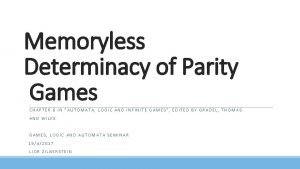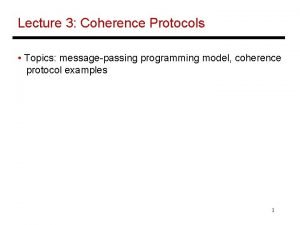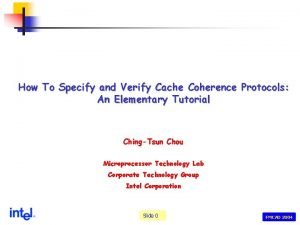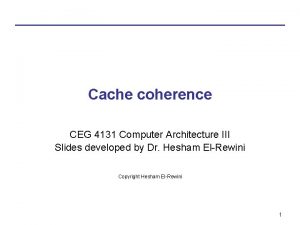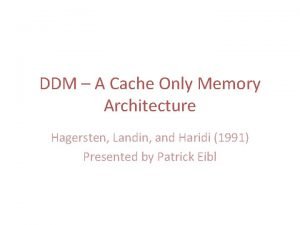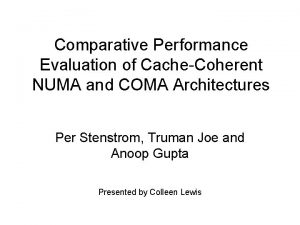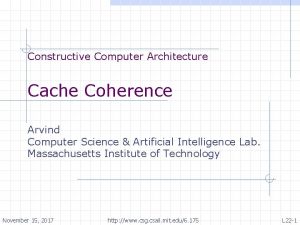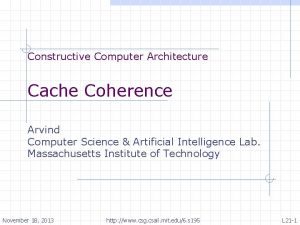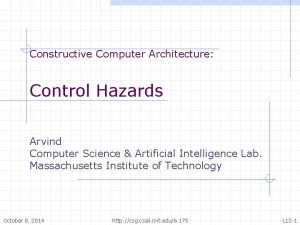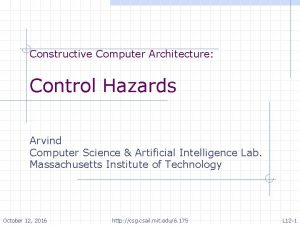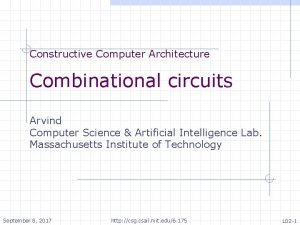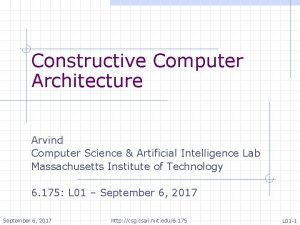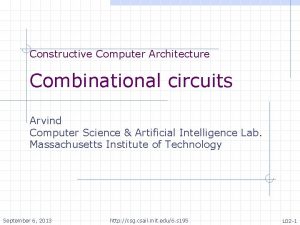Constructive Computer Architecture Cache Coherence Arvind Computer Science











- Slides: 11

Constructive Computer Architecture Cache Coherence Arvind Computer Science & Artificial Intelligence Lab. Massachusetts Institute of Technology November 21, 2014 http: //www. csg. csail. mit. edu/6. 175 L 23 -1

Further issues Are these rules enough, i. e. , complete? Effect of blocking vs non-blocking caches Communication systems and buffer requirements to avoid deadlocks November 21, 2014 http: //www. csg. csail. mit. edu/6. 175 L 23 -2

Are the rules exhaustive? Parent rules 2. Parent to Child: Upgrade-to-y response ( j, m. waitc[j][a]=No) & c 2 m. msg=<Req, c m, a, y, -> & ( i≠c, Is. Compatible(m. child[i][a], y)) m 2 c. enq(<Resp, m c, a, y, (if (m. child[c][a]=I) then m. data[a] else -)>); m. child[c][a]: =y; c 2 m. deq; What if the guard fails because 1. some child is not in compatible state? or 2. some child is in wait state? if condition 1 holds then rule 4 can be invoked if condition 2 holds then rule 4 must have been invoked and the each child will eventually send a response November 21, 2014 http: //www. csg. csail. mit. edu/6. 175 L 23 -3

Is every rule necessary? Consider rule 7 for cache 7. Child receiving downgrade-to-y request (m 2 c. msg=<Req, m c, a, y, - >) & (c. state[a]≤y) m 2 c. deq; A downgrade request comes but the cache is already in the downgraded state Can happen because of voluntary downgrade 8. Child to Parent: Downgrade-to-y response (vol) (c. waitp[a]=No) & (c. state[a]>y) c 2 m. enq(<Resp, c->m, a, y, (if (c. state[a]=M) then c. data[a] else - )>); c. state[a]: =y; November 21, 2014 http: //www. csg. csail. mit. edu/6. 175 L 23 -4

More rules? How about a voluntary upgrade rule from parent? Parent to Child: Upgrade-to-S response (vol) (m. waitc[c][a]=No) & (m. cstate[c][a]=S) m 2 c. enq(<Resp, m->c, a, M, -); m. cstate[c][a]: =M; The child could have simultaneously evicted the line, in which case the parent eventually makes m. cstate[c][a] = I while the child makes its c. state[a] = M. This breaks our invariant A cc protocol is like a Swiss watch, even the smallest change can easily (and usually does) introduce bugs November 21, 2014 http: //www. csg. csail. mit. edu/6. 175 L 23 -5

More rules? How about a “silent drop” 8 a. Child to Parent: Downgrade-S-to-I response (vol) (c. waitp[a]=No) & (c. state[a]=S) c 2 m. enq(<Resp, c->m, a, y, (if (c. state[a]=M) then c. data[a] else - )>); c. state[a]: =I; November 21, 2014 http: //www. csg. csail. mit. edu/6. 175 L 23 -6

A Directory-based Protocol an abstract view P p 2 m L 1 PP P m 2 p c 2 m interconnect m 2 c in p 2 m PP L 1 out PP m Each cache has 2 pairs of queues n (c 2 m, m 2 c) to communicate with the memory n (p 2 m, m 2 p) to communicate with the processor Message format: <cmd, src dst, a, s, data> Req/Resp address state FIFO message passing between each (src dst) pair except a Req cannot block a Resp Req messages from p to m cannot block Req messages from m to p November 21, 2014 http: //www. csg. csail. mit. edu/6. 175 L 23 -7

Communication Network P L 1 Interconnect Mem Two virtual networks: n n For requests and responses from cache to memory For requests and responses from memory to caches Each network has H and L priority messages a L message can never block an H message other than that messages are delivered in FIFO order November 21, 2014 http: //www. csg. csail. mit. edu/6. 175 L 23 -8

H and L Priority Messages At the memory, unprocessed request messages cannot block reply messages. H and L messages can share the same wires but must have separate queues H L November 21, 2014 An L message can be processed only if H queue is empty http: //www. csg. csail. mit. edu/6. 175 L 23 -9

FIFO property of queues If FIFO property is not enforced, then the protocol can either deadlock or update with wrong data A deadlock scenario: 1. 2. 3. 4. 5. 6. 7. msg 1: Child 1 requests (I -> M) upgrade msg 2: Parent responds to Child 1 with upgrade (I -> M) msg 3: Child 2 requests (I -> M) upgrade msg 4: Parent requests Child 1 (M -> I) downgrade msg 4 overtakes msg 2 Child 1 sees msg 4 and drops it Parent never gets a response from Child 1 for msg 4 November 21, 2014 http: //www. csg. csail. mit. edu/6. 175 L 23 -10

Deadlocks due to buffer space A cache or memory always accepts a response, thus responses will always drain from the network From the children to the parent, two buffers are needed to implement the H-L priority. A child’s req can be blocked and generate more requests From parent to all the children, just one buffer is needed for both requests and responses because a parent’s req only generates responses November 21, 2014 http: //www. csg. csail. mit. edu/6. 175 L 23 -11
 Constructive proof vs non constructive
Constructive proof vs non constructive Constructive proof vs non constructive
Constructive proof vs non constructive Non constructive proof
Non constructive proof Proof by contradiction examples
Proof by contradiction examples Cache coherence protocols
Cache coherence protocols Gpu cache coherence
Gpu cache coherence Read-through cache
Read-through cache Cache coherence tutorial
Cache coherence tutorial Chained cache coherence protocol
Chained cache coherence protocol Cache coherence example
Cache coherence example Cache only memory architecture
Cache only memory architecture Cache only memory architecture
Cache only memory architecture

